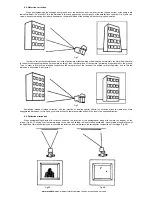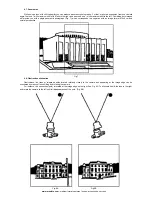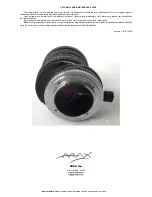
www.araxfoto.com
- medium format cameras, lenses, accessories , services
4. OPERATIONS INSTRUCTIONS
4.1. Lens installation on the camera and its removal
While superposing the indexes on the lens’ bayonet and the camera’s body install the lens on the body and turn it in the direction
recommended in the camera’s operation manual, securing it in the usual fashion.
To remove the lens take the bayonet’s knurled ring, press the camera’s latch and turn the lens up to the stop. Then remove it from
the camera.
4.2 Focusing
It is preferable to perform focusing at maximum aperture by rotating the focusing ring 1, on which focusing scale (distance) 2 is
marked. If focusing is required after shifting the optical block, then the microprisms or camera viewfinder wedges’ surface dim out. In
this case it is necessary to control image sharpness according to the screen’s matte area.
During optical block shifting, decrease the aperture as far as possible, because unequal amounts of the light falls on the edges and
center of the field. It is recommended to use the aperture values from 16 to 22.
4.3. Aperture operation
Manual aperture operation is provided for in the lens. Select the value by rotation of the ring 4, first pulling it aside along the optical
axis towards the camera. In the released condition rotate the ring 4 from set up value to the value 2,8. Before exposure do not forget to
rotate the ring 4 until the selected value of the aperture appears.
4.4. Lens shifting
While rotating handle 5, the lens is moving in parallel to the image surface. Furthermore, it can be rotated by 360
о
with settled
interval every 30
о
(the lens can operate even in the positions between these intervals). Due to the fact that the camera’s image is
rectangular, the limit degree of lens shift will be changing at every rotation. The maximal shift is possible at the settled position of the
lens along the image’s short side. To prevent vignetting, watch closely the digits of scale 7, pointing out the optimal value of the optical
block shifting. Control this shift on the scale 6. Its colored markings should correspond to the digits color on the scale 7.






